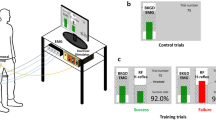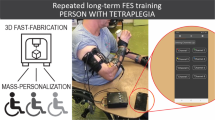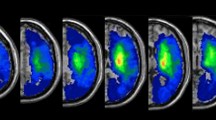Abstract
The interplay between stretch reflex and flexion reflex is discussed. A drug, which should have an inhibiting effect on the polysynaptic flexion reflex and on the gamma afferents was examined in walking tests in six children with cerebral palsy. The improvement obtained was probably due to a training effect. In 21 patients with different spinal cord lesions the flexion reflex of the lower limb was examined electromyographically by way of an electric nociceptive stimulus with needles inserted under the skin of the sole of the foot. This was done in a double-blind test, but no objective measurement could be obtained.
The flexion reflex was only obtained when the stimulus had a moving or nociceptive character. It was concluded that the flexion reflex probably has more qualities than withdrawal in defence. The importance of the widened receptive field in patients with paraplegia and a moving character of stimulus are stressed.
Similar content being viewed by others
Log in or create a free account to read this content
Gain free access to this article, as well as selected content from this journal and more on nature.com
or
References
Harpuder, K (Oct. 1962), Proceedings of Clinical Spinal Cord Injury, Veterans Administration, p. 32.
Kugelberg, E (1948). Brain, 71, 304.
Kugelberg, E, Eklund, K & Grimsby, L (1960). Brain, 83, 394.
Marshall, J (1954). Brain, 77, 290.
Pedersen, E & Schleisner, P (1959). Acta psychiat. scand. 34, 342.
Pool, G M (1965). Int. J. Paraplegia, 3, 188.
Rushworth, G (1964). Ann. phys. Med. Suppl.
Author information
Authors and Affiliations
Rights and permissions
About this article
Cite this article
Pool, G. Flexion reflex and stretch reflex in spasticity. Spinal Cord 4, 141–146 (1966). https://doi.org/10.1038/sc.1966.14
Issue date:
DOI: https://doi.org/10.1038/sc.1966.14



